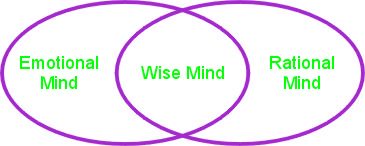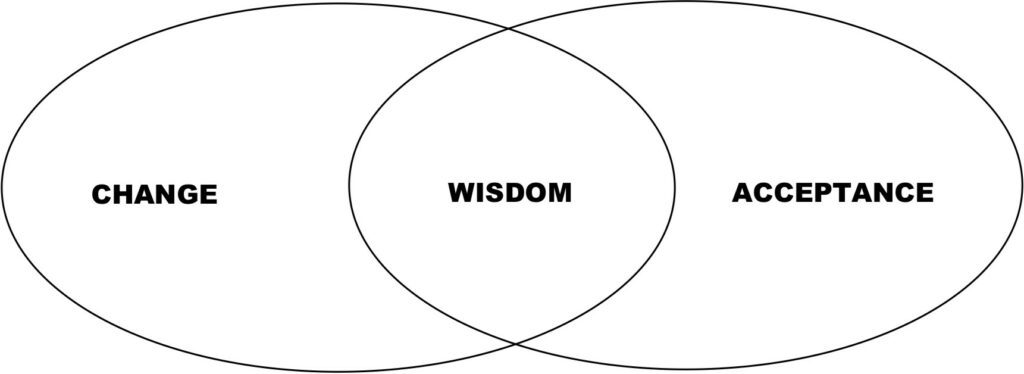What is Mindfulness?
Mindfulness is a type of focused attention, sometimes described as “falling awake.” Kabat-Zinn (2003) refers to mindfulness as “paying attention on purpose, in the present moment, and non-judgmentally to the unfolding of experience moment by moment.” It is a way of leaving doing mode and entering being mode. Mindfulness is especially helpful in dealing with anxiety and depression.
Doing Mode vs. Being Mode
We are so accustomed to getting things done in our busy lives, that learning to stop “doing” is sometimes difficult. Mindfulness is a way to stop doing and enter into being mode. In being mode, rumination and avoidance behaviors cease, and there is less of a tendency to get trapped in self-reinforcing negative cycles of behavior.
Thinking mode is to doing mode as sensing mode is to being mode. Thinking is a thing that we do, where sensing (perceiving, participating) is simply a state of being.
Wise Mind
When we are in a state of emotional dis-regulation, subject to wild mood swings and being driven by our feelings, we are said to be in emotional mind. On the other hand, when we are using pure logic and reason, totally devoid of feeling and emotion, we are said to be in rational mind.
A goal of mindfulness is to achieve wise mind, which is a balance of emotional mind and rational mind in perfect harmony.

Observing
Observing can be defined as, “The mindful technique of directing attention to a particular event or activity, while not engaging directly in that event or activity.” Observing is a type of sensing the environment around you or your own inner state, or entering into being mode. It allows you to disengage from your thoughts and feelings, and simply observe them.
Describing
Describing can be defined as, “The mindful technique of focusing on the details of an event or activity, sensing the components of that activity, and then defining the experience without necessarily having to engage in the experience.”
Fully Participating
Fully participating can be defined as, “Living only in the present moment, devoid of thoughts, feelings or anxiety about the past or the future, while focusing only on the present moment.”
Mindful awareness allows you to experience every aspect of an activity. We have a tendency, when in thinking mode, to see things and activities as either “all bad” or “all good.” This is not necessarily an accurate depiction of reality. In reality, there is a little good in most bad things, and a little bad in most good things. Fully participating allows us to engage in all aspects of the present moment.
Being Non-Judgmental
We often act as if there is some objective standard of perfection that we are trying to live up to, but when we learn to be non-judgmental, we learn that perfection is subjective. Not only is it subjective, but we are the ones who define it ourselves. By being non-judgmental, we give ourselves permission to make mistakes once in a while. It is through our mistakes that we learn and grow.
Focusing on One Thing at a Time
Focusing your attention on one activity, and one activity only, such as enjoying each bite of a meal, is an example of focusing on one thing at a time. Mindful awareness allows one to become fully aware and to participate in every activity as if experiencing it for the first time.
The Power of Intention
The Power of Intention involves taking a solution-focused approach to problem-solving. If your intention is to carve an elephant, then you chip away anything that doesn’t look like an elephant. Mindfulness allows us to hone our power of intention so that our lives are lived deliberately, with purpose, and with full awareness, chipping away anything that doesn’t look like a purpose-driven life. From a therapeutic perspective, the Power of Intention works well with solution-focused forms of therapy, such as Narrative Therapy or Solution-Focused Brief Therapy, or Cognitive Behavioral Therapy.
Acceptance vs. Change
An example of the Acceptance vs. Change dialectic would be the Serenity Prayer, which states, “God grant me the serenity to accept the things I cannot change; courage to change the things I can; and wisdom to know the difference.” One of the paradoxes of mindfulness is that you must accept yourself as you are before you can change. This is summed up succinctly by Marsha Linehan as, “You’re perfect. Now change.”

Radical Acceptance
A question commonly asked in order to learn radical acceptance is, “What if this is as good as it gets?” This does not mean we are taking on a defeatist attitude; instead, it means recognizing that the purpose of life is not to avoid problems, but to learn to deal with them effectively in the moment.
Letting Go
Radical acceptance is used to facilitate the process of letting go. This means letting go of the anxiety associated with a problem, without letting go of the problem itself. When we have problems in relationships with others, a way of dealing with it is to remember the phrase, “Never overestimate your ability to change others; never underestimate your ability to change yourself.”
By realizing that we cannot change anyone but ourselves, we learn to let go of the need to try to change others.
Crystal Ball Thinking
Mindfulness involves paying attention only to the present moment, which is all we really have. If we are focused on worries about the past, or anxieties about the future, we are not living in the present moment. We cannot change the past, and unless we have a crystal ball, we cannot predict the future. When we try to do so, we are not living in the present moment; instead, we are engaging in Crystal Ball Thinking.
True Self
Descartes said, “I think, therefore I am.” Does that mean that if we stop thinking, we cease to exist? Of course not. We are not our thoughts or our feelings. What we are is the internal observer that watches our thoughts and feelings. This internal observer is called the True Self.
Mindful Breathing
Mindfulness is simply a heightened state of awareness. The practice of mindful meditation can focus on anything, but one of the first things a practitioner of mindfulness learns to focus on is the breath, since the breath is always present. By focusing on the breath and only on the breath, we leave the world of doing and enter the world of being.
Mindfulness-Based Cognitive Behavioral Models of Therapy
Cognitive Behavioral Therapy works to modify maladaptive thought and belief patterns commonly referred to as thinking errors. The theory is that by modifying the beliefs, the behaviors will change. These beliefs are what to change; Mindfulness is how to change the beliefs.
Acceptance and Commitment Therapy (ACT)
Acceptance and Commitment Therapy is a type of mindfulness-based therapy based on Relational Frame Theory (RFT). It is a type of Contextual Therapy that works to increase acceptance and to generate commitment to acceptance as a lifelong process.
Dialectical Behavior Therapy (DBT)
DBT was founded by Marsha Linehan as a method of treating Borderline Personality Disorder. It has four basic skill sets. These are:
- Mindfulness Skills
- Distress Tolerance Skills
- Emotional Regulation Skills
- Interpersonal Effectiveness Skills
DBT is based on the concept of the Hegelian Dialectic of thesis/antithesis/synthesis. It works to achieve a balance between polar opposites.
Mindfulness-Based Cognitive Therapy (MBCT)
MBCT was developed from MBSR as a means of preventing relapse in patients with clinical depression. Students of MBCT learn the specific states and conditions that leave them vulnerable to downward spirals of depression. MBCT also uses radical acceptance strategies to help patients overcome feelings of inadequacy that lead to cycles of depression. Research into the effectiveness of MBCT in preventing relapse (a return to depressive symptoms) demonstrates that the techniques of MBCT can reduce rates of depressive relapse by as much as 50%.
Mindfulness-Based Stress Reduction (MBSR)
MBSR was developed by Kabat-Zinn in the 1970s at the University of Massachusetts. MBSR is an eight-week intensive course in using Mindfulness as a tool to reduce stress. The core concept of MBSR is to learn to step out of „autopilot‟ and to become fully aware of what is happening in our lives at any given moment. MBSR and Mindfulness continue to demonstrate a wide variety of applications for a large range of mental and physical health issues.
Mindfulness and Spirituality
In certain regions of the United States and the world, meditation is mistakenly associated with cults and mysticism. This sometimes leads to resistance in treatment. One way of dealing with this resistance is to simply avoid using the term mindfulness. Another is to explain to patients that mindfulness is merely a way of heightening awareness. What mindfulness does is to increase awareness and enhance the stillness so a practitioner may experience the divine in his or her own way. Mindfulness is more than just a meditative technique. It is a way of seeing the world is it really is, without the filter of our assumptions and expectations. By viewing the world through mindful eyes, we experience a paradigm shift. This shift in perception allows us to change the things we can, and to accept the things we cannot change. Such a worldview is at the heart of every religious practice.

